Last Updated on January 19, 2024 by Greg Gillson
You’ve decided to start feeding wild birds this winter and want to know how to get started. Welcome!
Or, perhaps you’ve been feeding backyard birds but are looking for new ideas. Wonderful!
Maybe a certain bird at your feeder has attracted your interest. You want to know what it is. You’ve come to the right place!
I’ve written this article to address all these scenarios.
This article tells why and how to set up a bird feeder in Indiana in the winter. I’ll also show you photos of the common feeder birds in Indiana that you can look for at your own backyard feeder! I will give brief identification tips. I will tell you what foods and what type of feeders attract each species.
Winters are cold and frigid in Indiana. Most days are below freezing. Snow is frequent.
I understand that ice skating and ice fishing are popular winter time activities in Indiana.
How about I recommend a warmer winter past time? Backyard bird feeding and watching!
You don’t need special clothes to watch birds from your window. And you’re not as likely to get skunked as you might when ice fishing.
Why feed winter birds in Indiana?
Indiana is positioned ideally for winter bird watching.
Indiana is in the Mississippi flyway. Many birds migrate north and south through this region. On the other hand, there are many birds, also, that live year-round in the area.
The state’s northern latitude means there is a good turn-over over birds between summer and winter.
And the snowy weather means that birds are hungry and quickly attracted to feeders in winter.
By feeding birds and managing your landscaping to attract wildlife, you can help these wonderful creatures to survive the sometimes harsh Indiana winters.
We all need more connection to nature. And what better way than birds? They are active during the day. There are many interesting varieties and colors. Many are not overly fearful of human activity, thus they are easy to observe. Many are easily attracted to our backyards.
These wild creatures are the perfect antidote to the stress and hubbub of modern living. Don’t watch the depressing news. Relax and watch the birds at your feeders!
Feeding and watching winter birds in Indiana can bring you joy.
What birds come to feeders in winter in Indiana?
Simply by providing a couple different types of seed or nuts, you can attract a score of birds to your feeders.
Most of the backyard birds in winter in Indiana are seed eaters or omnivores. Most of the insect eaters and fruit eaters have all migrated southward, if they can’t switch to plant material.
So with little effort you can attract these feathered balls of energy into your view. Every day.
Of course, you can feed and watch birds without knowing their names.
But there is something exciting about having a new species come to your feeder. Watching for something new and different keeps your interest. It provides incentive to refill your feeders on those less-than-ideal-weather days.
You can even track the coming and going of some birds through the year.
If you start identifying the winter birds at your feeder, something else may happen. You may start watching birds in your backyard all year long. When you get to that spot in your bird watching, you’ll want to check out my article: What birds are in my backyard in Indiana? It discusses the most common backyard birds throughout the year–even those that don’t come to feeders. I’ll link to that article again at the end, so you can keep reading here and visit afterward.
Pretty soon you may want to travel to other locales and habitats to add new species to your list. Now you’re hooked on bird watching!
Let’s start with the more common feeder birds you can expect in Indiana in winter.
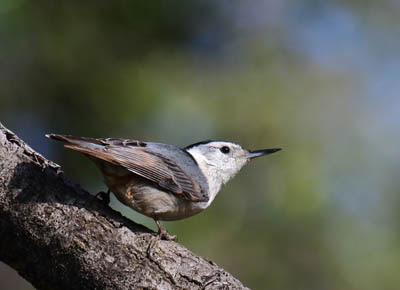 |
| White-breasted Nuthatch. Greg Gillson. |
White-breasted Nuthatch
This active little bird crawls up, down, over, and under, tree trunks and main branches.
These birds live in deciduous and mixed woods in the East, oaks and pine-oak woodlands in the West. They are found from central Canada southward into Mexico.
White-breasted Nuthatches are year-round residents throughout Indiana.
Nuthatches are small plump birds with big heads and very short square tails. The bill is medium length (about as long as the head) and pointed. Legs are short, feet large and strong.
These birds are gray or blue-gray above, with a thin black strip over the top of the head. The underparts and side of the head and face is white. They often show some rusty along the flank and under the tail.
White-breasted Nuthatches love black oil sunflower seeds, peanuts, and tree nuts from any kind of feeder. They also eat suet.
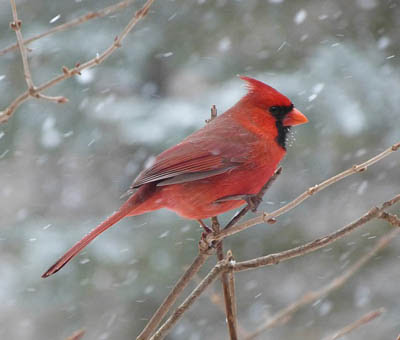 |
| Northern Cardinal. tlparadis from Pixabay. |
Northern Cardinal
The male cardinal’s image, if not the bird itself, is probably the most well-known bird in the United States.
These birds are found in woodlands and backyards in the Eastern US west to North Dakota, Texas and Arizona.
Northern Cardinals are year-round residents in Indiana.
These are fairly large plump birds. The have a huge conical bill. The tail is full and rounded. The crest is obvious.
Males are bright scarlet red with black face and orange bill. Females are tan or gray with red highlights, but otherwise have the obvious bill and crest and dark face.
Northern Cardinals eat larger seeds, including sunflower and safflower seeds, especially from platform feeders and the ground.
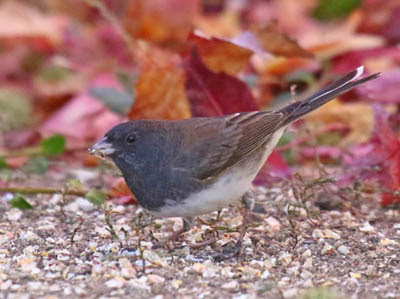 |
| Dark-eyed Junco. Greg Gillson. |
Dark-eyed Junco
When these “snowbirds” arrive at your feeders, winter is nigh.
These birds live in conifer and mixed woodlands across Canada and in the mountains of both eastern and western United States. In winter they descend to the lowlands and south across most of the US, mostly abandoning Canada.
Dark-eyed Juncos are winter visitors to Indiana.
These are small plump birds with large heads. The conical bills are small.
The form found in the eastern US (sometimes called Slate-colored Junco) is rather dark gray throughout with a white belly. Females are browner on the back. Both genders sport flashing white outer tail feathers. Bill and legs are pink.
Dark-eyed Juncos like small mixed seeds, including white proso millet, from low platform feeders, but are more likely on the ground.
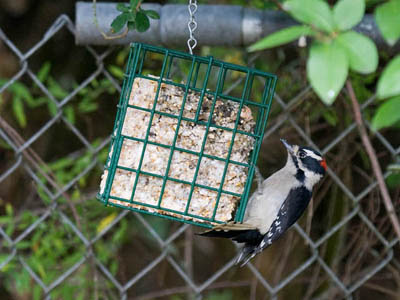 |
| Downy Woodpecker. Greg Gillson. |
Downy Woodpecker
These little woodpeckers are common backyard visitors across the United States.
These woodpeckers are residents across Alaska, Canada, and most of the United States except the deserts.
Downy Woodpeckers are year-round residents throughout Indiana.
These are small stocky birds with short tails, short legs. The bill is pointed and rather small compared to other woodpeckers.
The black-and-white plumage is similar to many other woodpeckers. The have black wings with white spots. The back and under parts are white. The tail is black with white outer tail feathers. The head is white with black crown, black ear patch, and black lateral throat stripe. Males have a small red spot on the back of the head.
Downy Woodpeckers eat suet and peanuts.
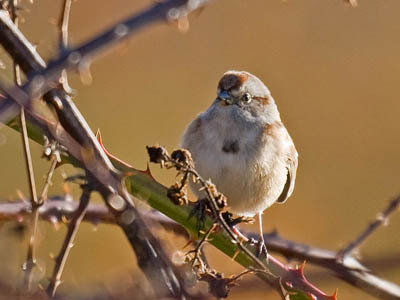 |
| American Tree Sparrow. Greg Gillson. |
American Tree Sparrow
This northern bird is not well-known, except as a rare feeder visitor in winter.
These birds breed where scattered trees give way to tundra, across Alaska and northern Canada. They winter in weedy fields across most of the northern United States.
American Tree Sparrows winter throughout Indiana.
These are rather small sparrows, medium in build.
These birds are rather pale gray with rufous highlights. The back is brown with dark stripes. The wing is reddish brown with two white wing bars. The head is gray with rusty orange crown. The gray breast has a large dark spot in the center. The bicolored bill is dark above and yellow below. The legs are pink.
American Tree Sparrows eat small mixed seeds, including white proso millet, on platform feeders or the ground.
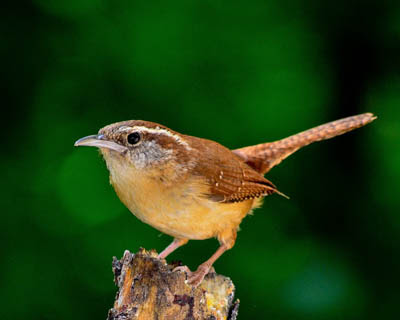 |
| Carolina Wren. theSOARnet from Pixabay. |
Carolina Wren
These loud songsters may be in your yard year-round, but perhaps only visit your feeder in winter.
These brush-loving birds are common in the East and Southeast. Populations expand northward after mild winters, but retract after harsh winters.
Carolina Wrens are year-round residents throughout Indiana.
These are plump birds on longer legs. They have a larger head with long curved bill. The tail is long and full.
These birds are brown above, with black bars on the wing and tail. They have a long white eyebrow stripe. The under parts are rich buffy.
Carolina Wrens come to suet feeders in winter.
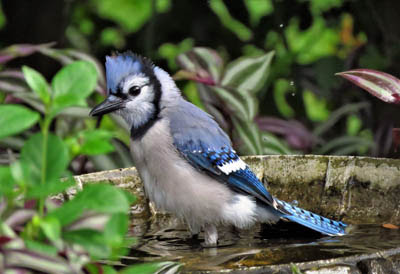 |
| Blue Jay. Skeeze from Pixabay. |
Blue Jay
This is such a well-known bird that many other jays and bluebirds get called “blue jays” by those who aren’t familiar with the differences.
These birds live in deciduous woodlands, especially those containing oaks or other nut trees. They are found east of the Rocky Mountains from southern Canada southward.
Blue Jays are year-round residents throughout Indiana.
These are medium large backyard birds with a large crested head and ample tail. They have a long pointed and stout bill.
Generally, they are blue above and pale gray below. The crest and back are blue. The wings and tail are blue with black bars. There is a big patch of white in the wing and also on the tail corners. The white face is enclosed by a black necklace that goes across the chest and over the back of the neck.
Blue Jays are fond of nuts, peanuts, and sunflower seeds at hopper feeders. They also love suet.
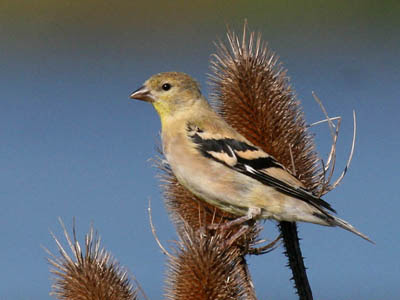 |
| American Goldfinch. Greg Gillson. |
American Goldfinch
The bright yellow males of summer with their black cap, wings, and tail are well known. The dull brown winter plumage can be confusing.
These birds live in weedy grasslands with sparse trees. They breed from southern Canada to the mid-latitudes of the Unites States. In winter they migrate south to winter throughout the US.
American Goldfinches are year-round residents throughout Indiana.
These are small birds with small round heads and a short forked tail. The bill is conical, but short.
In winter the bright yellow and black plumage gives way to a pale brown body color with yellow throat. Wings are dark brown with wide pale wing bars.
American Goldfinches love Niger seed from thistle feeders. They also eat black oil sunflower seeds from tube feeders.
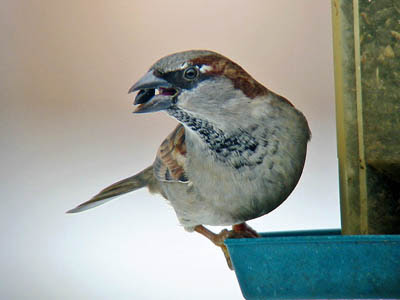 |
| House Sparrow. Greg Gillson. |
House Sparrow
These city birds sometimes form large noisy and messy flocks at feeders.
These birds are found in city and residential areas, as well as livestock farms, from Canada to Mexico.
House Sparrows are year-round residents throughout Indiana.
Plump birds with short legs, medium-short tails and large flat heads with big conical bills.
Brown above and gray below. Females have a broad pale eyebrow. Males have gray crown, chestnut ear patch and black mask and throat (only a scruffy black chin in winter). Adult males have black bill, females and young males have pale bill.
House Sparrows like smaller mixed seed, especially the red milo, wheat, and cracked corn found in cheap bird seed. They prefer hopper feeders. (Thus, to discourage these birds, feed black oil sunflower seed from tube feeders.)
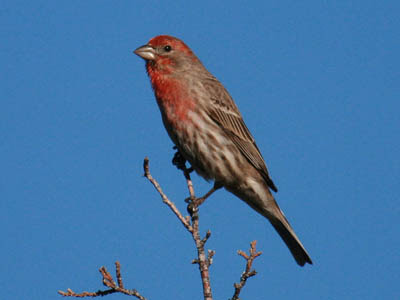 |
| House Finch. Greg Gillson. |
House Finch
This is the most likely red finch at your feeder in the United States, especially if you live in town.
More widespread in their native canyonland range of the West, in the East, where introduced, these birds prefer residential areas over wild spaces. They are residents from extreme southern Canada into Mexico.
House Finches are year-round residents throughout Indiana.
These birds are small with fairly long body and round head. The tail is notched or slightly forked.
They are dusty brown above. The underparts are covered with broad brown streaks. Males have a red forehead, upper breast, and rump. The bills are conical, with a curved upper bill.
House Finches love black oil sunflower seeds from tube feeders.
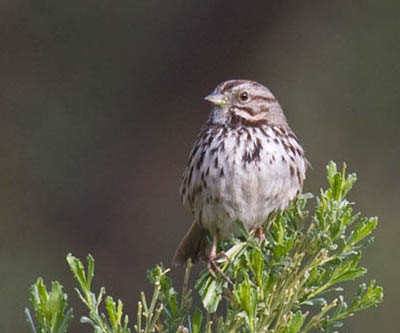 |
| Song Sparrow. Greg Gillson. |
Song Sparrow
These birds are rather shy at your feeder. They may prefer to look for seeds under your hedge or on the ground below your feeder. Or they may sneak onto the feeder when there are no other birds feeding.
These birds love brushy tangles and hedges, from marshes to forest clearings, but also residential areas. They breed from southern Alaska, across Canada and much of the United States. In winter they are found across the US, including Texas and the Gulf coast, where they are absent in summer.
Song Sparrows are year-round residents throughout Indiana.
These are small round birds with a long rounded-tip tail.
These are gray above with both light and dark brown stripes. The head is striped with brown on a gray background, The under parts are white with wide streaks on the upper breast that often converge on the center of the breast.
Song Sparrows love small mixed seeds from low platform feeders or feed on the ground under the feeders.
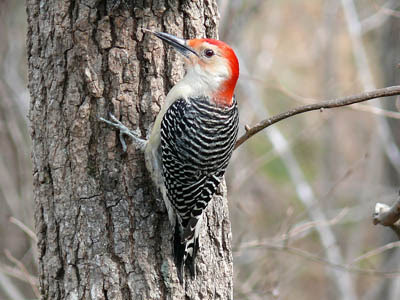 |
| Red-bellied Woodpecker. Skeeze from Pixabay. |
Red-bellied Woodpecker
These eastern woodpeckers commonly visit bird feeders in winter.
These birds live in woodlands, parks, and residential areas with larger trees. Found in the eastern United States, west to the Dakotas and Texas.
Red-bellied Woodpeckers are year-round residents throughout Indiana.
These are medium-sized birds, smaller than a robin. They are stocky with short tails and large heads and long pointed bill. Legs are short, feet strong.
The body and head is pale. The back and wings are barred black-and-white. The back of the head is red, extending over the crown on males. In flight birds show white primary wing patches and white rump.
Red-bellied Woodpeckers eat suet. They also come to platform feeders for peanuts, nuts, and sunflower seeds.
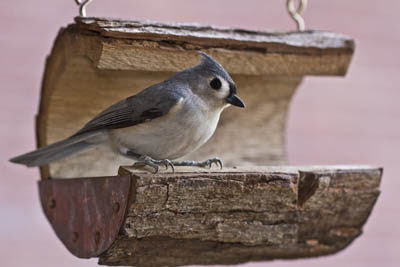 |
| Tufted Titmouse. Anne773 from Pixabay. |
Tufted Titmouse
These birds are a bit less active than chickadees, but are very similar in habits.
These birds are found in deciduous woods and parks. They are found throughout the East, and west to Minnesota and eastern Texas.
Tufted Titmouses are year-round residents throughout Indiana.
These birds are plump with a big head and thick tail. They have a stout short bill and short, rather inconspicuous crest.
These birds are blue-gray above and pale gray below. They have a peach cast to the flanks, The forehead is black.
Tufted Titmouses like peanuts and black oil sunflower seeds from hopper feeders.
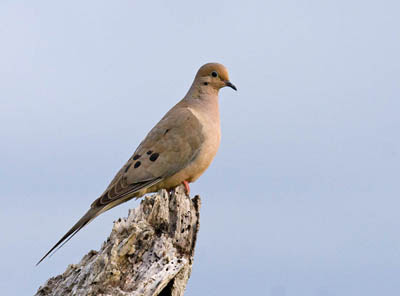 |
| Mourning Dove. Greg Gillson. |
Mourning Dove
Besides coming to your bird feeder, in spring these birds nest on shelfs on porches and in carports.
Found in a wide variety of open habitats, including residential areas and woods along streams. Breed across southern Canada southward into Mexico. In winter birds retreat from Canada and the northern Great Plains.
Mourning Doves are year-round residents in Indiana.
These fairly large birds are quite plump with a large breast. They have a small round head on thin neck. Their tail is very long and pointed. Legs are short. The bill is small and rather thin, slightly hooked at the tip.
The back and wings of these birds is gray and brown. The wing coverts have large black spots. The under parts are more pinkish. The tail has white outer feathers.
Mourning Doves eat a wide variety of grains and seeds, including cracked corn, sunflower seeds, and millet, from a platform feeder.
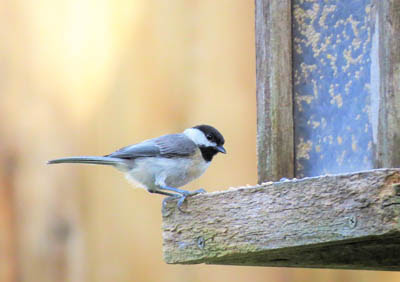 |
| Carolina Chickadee. GeorgeB2 from Pixabay. |
Carolina Chickadee
These chickadees replace the Black-capped Chickadees in the southeastern United States.
These chickadees live in deciduous woods and residential areas. They are resident in the Southeast United States, north to New Jersey, west to southern Nebraska and the Texas panhandle, and south to northern Florida.
Carolina Chickadees are resident year-round in the south half of Indiana. In the northern third of Indiana they are replaced by Black-capped Chickadees. There is some overlap.
These are small plump birds with big heads and long active tails. The bills are short and stout. The legs and feet strong.
These birds have gray back, wings, and tail. The under parts are pale. The white face is offset by black cap and black bib. The wings are rather plain gray; Black-capped has white feather edges more obvious on the wing edges. Voice is also different; please see Cornell’s online field guide for more details.
Carolina Chickadees love black oil sunflower seeds from tube or hopper feeders.
Setting up a winter bird feeding station in Indiana
Usually I recommend having two feeders, usually a tube feeder with black oil sunflower seeds for the finches and chickadees, and a hopper feeder with mixed seed for the sparrows and other birds.
However, I think a larger hopper feeder with a good quality mixed seed that is 50% sunflower seeds would attract the most of the expected birds. I recommend Wagner’s Songbird Supreme.
All birds will come to a hopper feeder. And that Wagner’s mixed seed will attract most of the species shown above.
I’d also set up a suet feeder. It provides needed calories for those cold winters! Birds that will come to the suet includes wrens, woodpeckers, chickadees, jays, and nuthatches.
I recommend a bird bath for a source of liquid water–especially in the frozen winter. I don’t have a recommendation for a bird bath heater, but do recommend you think about providing one.
You may find the best of these foods and feeders on my recommended product page. Also, see the article below on my recommended bird feeder setup.
Wrapping Up
Indiana plays a critical role as a wintering ground on the Mississippi Flyway for countless bird species, thanks to a combination of factors that make it an ideal haven during harsh northern winters:
Habitat Diversity
Indiana boasts a rich tapestry of landscapes, including wetlands, forests, grasslands, and agricultural fields. This diversity provides a variety of food and shelter options for different bird species throughout the winter.
Wetlands and lakes offer rich foraging grounds for ducks, geese, swans, and shorebirds, while forests provide cover and food for songbirds like woodpeckers, finches, and sparrows.
Agricultural fields attract birds like geese, blackbirds, and starlings seeking leftover grain and seeds.
Abundant Food Sources
Indiana’s abundant natural resources and farmland ensure a steady supply of food for wintering birds. Wetlands teem with aquatic insects, fish, and mollusks, a crucial source of protein for many waterfowl species.
Forests offer berries, nuts, and even insects available under the bark for foraging birds and agricultural fields provide leftover grain and seeds, especially valuable when snowfall covers other food sources.
Milder Climate
Compared to regions further north, Indiana experiences milder winter temperatures and less snowfall. This allows many bird species to survive without expending as much energy finding food and keeping warm. Open water sources like rivers and springs stay unfrozen in many areas, providing crucial access to water for drinking and bathing.
Strategic Location
Indiana lies midway along the Mississippi Flyway, a major migration route for birds traveling between breeding grounds in Canada and wintering grounds in the Gulf of Mexico and beyond. This location makes it an ideal stopover point for migrating birds to rest and refuel before continuing their journey south.
Protected Areas
Indiana has numerous protected areas like national wildlife refuges and state parks that offer safe havens for wintering birds. These protected areas provide undisturbed foraging grounds, nesting sites, and shelter from predators and human activities.
Frequently Asked Questions
What birds stay all winter in Indiana?
Many birds brave the frosty Indiana winters and stick around throughout the season, adding a touch of life and beauty to the snowy landscape. Here are some other resident feathered friends that were not on my main list.
Red-tailed Hawks: These majestic birds soar above landscapes, surveying for prey like mice and rabbits.
Great Horned Owls: These silent hunters watch from perches, keeping smaller birds and mammals on their toes.
Owls: Eastern Screech-Owls and Barred Owls can also be found throughout the state, adding a touch of mystery to winter nights.
Canada Geese: These honking flocks grace lakes and waterways, often accompanied by ducks like Mallards and Gadwalls.
American Dippers: These small, water-loving birds dive into swift-moving streams, adding a touch of life to cold, rushing waters.
Do Cardinals stay in Indiana in winter?
Yes, Cardinals are well-known for staying in Indiana throughout the winter, making them a year-round resident in the state. Unlike many bird species that migrate south for warmer temperatures and abundant food sources, Cardinals readily adapt to colder conditions and find enough resources to survive the frosty months.
Cardinals do well in winter because they have thick feathers and excellent insulation, enabling them to handle harsh temperatures and can adjust their metabolism to conserve energy during cold nights.
Cardinals shift their diet from insects in summer to a winter focus on seeds, berries, and nuts. They will also readily visit bird feeders stocked with sunflower seeds, millet, and cracked corn. If needs be, they will forage by gleaning seeds from trees and shrubs, including winter favorites like dogwood and honeysuckle.
During winter, Cardinals often form small flocks for increased foraging efficiency and warmth. These flocks stay in contact with constant chirping, helping them locate food and stay safe from predators.
Why are there so many birds in my yard all of a sudden in winter?
Most often a sudden influx of birds in the winter months is for one main reason: food.
As winter progresses, natural food sources like berries, insects, and seeds become scarce in many areas. This drives birds to seek alternative food sources, often leading them to backyards with bird feeders or other offerings.
They may also seek shelter from snow and ice, which can further limit access to natural food, making birds even more dependent on readily available sources like your feeders.
Winter often sees birds forming flocks for warmth and improved foraging efficiency. If a flock discovers your yard as a reliable food source, you might witness a sudden increase in numbers.
Related Articles:







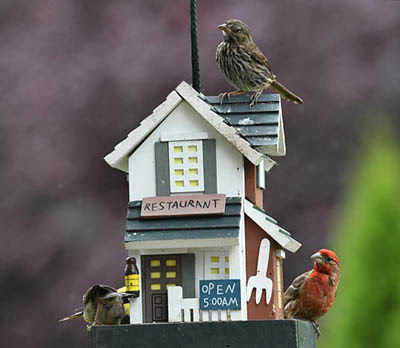




This article answered all of my questions about Winter feeding in Central Indiana. Informative, great pics. Many thanks.
Thank you!
Your content is thoughtfully written. I am in NW Indiana and trying to figure out what bird I am seeing in my backyard. It's about the size of a robin but is all gray, maybe 2 shades of gray, yellowish beak. Any idea? Thanks!
Yellowish beak doesn't sound quite right, but Gray Catbird and Northern Mockingbirds are our gray birds.
Oh, here's another thought. juvenile starlings are gray. While the beak is black, the mouth lining, inside, is yellow.
In fact, the yellow mouth lining is true of all juvenile birds. And this is the time for juvenile birds, which aren't as colorful as adutls.